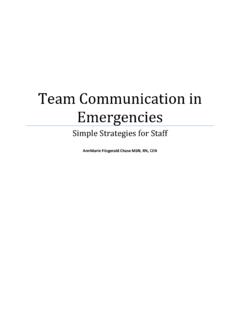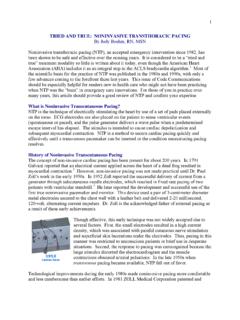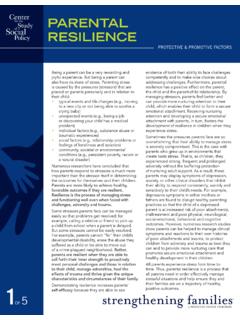Transcription of PC LE 061311 edits Pediatric Resuscitation Code ...
1 Introduction Cardiac arrest in the Pediatric population is an unfortunate and devastating occurrence. It is estimated that 16,000 American children suffer a cardiac arrest each Tragically, only 5% to 10% of patients survive out of hospital arrests and often with severe neurological Survival statistics for Pediatric cardiac arrests occurring in the hospital are somewhat better, with 27% of patients surviving to discharge and 65% of them leaving with good neurological Some Pediatric cardiac arrests are sudden and unexpected, especially those that occur outside the hospital. Warning signs can be absent or go unrecognized. Pediatric arrests often occur as a complication of, or progression of, respiratory failure, circulatory shock, or Although the cause may vary, the goal is the same: immediately reestablish effective cardiac output and deliver oxygen to tissues with high quality cardiopulmonary Resuscitation (CPR).
2 The difference in outcomes for out of hospital arrests compared to those than happen in the hospital can be attributed to the etiology of the arrests, how rapidly the situations are recognized, and the quality of the treatment by In this issue of code Communications, we will explore current Resuscitation research to help answer the following clinical queries: Why do children arrest? What challenges do clinicians face? Why should children not be treated as little adults for defibrillation? and What is in the future of Pediatric Resuscitation ? Why do children arrest? The potential causes of cardiac arrest in children are numerous. Complications from respiratory conditions, underlying cardiac abnormalities, trauma, and chronic pre existing conditions can all progress to cardiac arrest.
3 Respiratory Causes Most often, cardiac arrest in children is the result of a primary respiratory cause. Breathing conditions such as anaphylaxis, apnea, aspiration, asthma, bronchiolitis, epiglottitis, drowning, pneumonia, respiratory syncytial virus, smoke inhalation, and suffocation can quickly deteriorate into respiratory failure. Variable periods of systemic hypoxemia, hypercapnea, and acidosis occur, with progression to bradycardia and hypotension, terminating in cardiac Sudden infant death syndrome (SIDS) continues to be a phenomenon of unknown cause. Since 1992, when the American Academy of Pediatrics released it s Back to Sleep, 8 recommendation encouraging parents to place infants on their backs to sleep, the incidence has dropped significantly. The percentage of infants placed on their backs has increased by more than 50 percent since this campaign Nonetheless, and despite a remarkable reduction in rates over the past decade, SIDS is still responsible for more infant deaths in the United States than any other cause of death during Cardiac Causes Underlying structural abnormalities and electrical conditions can place children at risk of cardiac arrest.
4 Many of these conditions present without symptoms until the arrest. Structural conditions include arrhythmogenic right ventricular dysplasia, coronary artery abnormalities, dilated cardiomyopathy, hypertrophic cardiomyopathy, Kawasaki disease, Marfan syndrome, mitral valve prolapse, and myocarditis. The epsilon wave (marked by the red triangle) is found in about 50% of those with arrhythmogenic right ventricular dysplasia. This is described as a terminal notch in the QRS complex. It is due to slowed intraventricular conduction. The epsilon wave may be seen on a surface ECG; however, it is more commonly seen on signal averaged ECGs. Cardiac arrhythmias that can predispose children to cardiac arrest include Brugada syndrome, catecholaminergic polymorphic ventricular tachycardia (CPVT), long QT syndrome, and Wolf Parkinson White Brugada syndrome is characterized by ST segment abnormalities in leads V1 V3 on ECG and a high risk of ventricular arrhythmias and sudden CPVT is a rare, malignant ventricular tachycardia often occurring with exercise.
5 Most patients with CPVT experience ventricular fibrillation during syncope in other words, without treatment, patients with CPVT are prone to ventricular fibrillation (VF) and sudden Long QT syndrome ranges from asymptomatic ECG repolarization abnormalities to sudden death, 12 while Wolf Parkinson White Syndrome patients have an accessory pathway and therefore a predisposition to develop supraventricular The ECG also features two abnormalities, a short PQ interval and a delta wave. The supraventricular tachycardia patterns can turn into VF, putting patients at risk for sudden death. Most of these arrhythmias remain undetected until a cardiac arrest occurs. The media frequently highlight unexpected, sudden deaths in adolescent athletes. We know that the best preventive measure is to have all adolescent athletes in high school complete a pre participation physical that includes a thorough family history, an ECG, and asking questions that might uncover unusual symptoms.
6 These simple steps may identify a possible underlying cardiac abnormality. Unfortunately for many Pediatric patients, a pre participation physical is not required to play Saturday afternoon soccer with the town team. Unless children complain of shortness of breath, chest tightness or pain, or seizures, for example, the identification, treatment, and ultimately prevention of a catastrophic cardiac arrest may not be possible. Advocacy groups such as Sudden Arrythmia Death Syndromes and Parent Heart Watch are working diligently in the community to help promote improved preventative screening for children. Other Causes Commotio cordis is a rare traumatic event caused by a sudden blow to the chest at the moment when the ventricular myocardium is repolarizing, in the ascending phase of the T wave.
7 Other causes of Pediatric cardiac arrest include electrical shock, accidents, and impacts with a considerable degree of injury leading to shock and ultimately arrest. Various drugs and toxins can also speed up the heart, causing ventricular fibrillation. In hospital CPR events have also been documented in children with pre existing conditions, such as genetic, hematologic, immunologic, metabolic, or oncologic CPR and early defibrillation Resuscitation efforts that are geared to the Pediatric population in the hospital are often aimed at treating possible respiratory failure and/or shock or pre existing conditions, not sudden cardiac arrhythmias. If a child does not respond to interventions or continues to decompensate, the cardiac rhythm usually progresses through bradyarrhythmias to asystole or pulseless electrical arrest (PEA) rather than to Insert image of asystole and PEA here from ACLS poster left column.
8 Labeled as asystole and Pulseless Electrical Arrest A PEA or asystole event requires an organized, skilled Pediatric advanced life support (PALS) team to provide possible lifesaving treatment as soon as possible. High quality CPR is key to survival for these patients. Both PEA and asystole are not shockable cardiac rhythms. If there is no return of a shockable or life sustaining rhythm, the patient will not survive. Victims of Pediatric cardiac arrest in the community depend on bystanders to provide immediate Resuscitation . According to multiple studies referenced in the latest guidelines for Pediatric basic life support , only one third to one half of infants and children who suffer cardiac arrest receive bystander Pediatric patients who have a rhythm of pulseless ventricular tachycardia or ventricular fibrillation should be defibrillated as soon as a device is available and ready for use.
9 Most areas of the hospital are equipped with devices that can quickly be placed on a patient. Community access to automated external defibrillators (AEDS) is increasing, improving the chances for early defibrillation. What challenges do clinicians face? A Pediatric cardiac arrest is one of the most stressful situations a clinician can Prevention and treatment of the risk factors or precipitating causes that may lead to a cardiac arrest is always the focus of any medical team. Unfortunately, despite a medical team s best effort, some Pediatric patients will require Resuscitation from a cardiac arrest. Utilization of rapid response teams or medical emergency teams in the hospital can help to decrease mortality and morbidity from Pediatric cardiac arrests. Training and Maintaining Skills Clinicians who provide care for Pediatric patients train and prepare for cardiac arrests.
10 Enrollment in lifesaving courses such as Pediatric basic life support (BLS) and PALS is required every two years. The American Heart Association (AHA) coordinates the curriculum and includes requirements such as a low student to mannequin ratio. The hope is that all students will receive similar training. The traditional BLS or PALS class is held in a classroom environment with lectures and a short skill demonstration. Unless the hospital or unit provides more frequent training, the clinician may only practice these lifesaving skills every two years. This scenario creates a challenge for clinicians. Although many will never utilize their skills, is it reasonable to maintain an expectation that effective and high quality CPR will be given when it is required? The expectation is that clinicians meet the recommended CPR parameters related to rate, depth, and release of chest compressions, and ventilations while avoiding CPR free Resuscitation researchers have studied the accuracy of clinicians performing CPR according to the AHA Guidelines.








